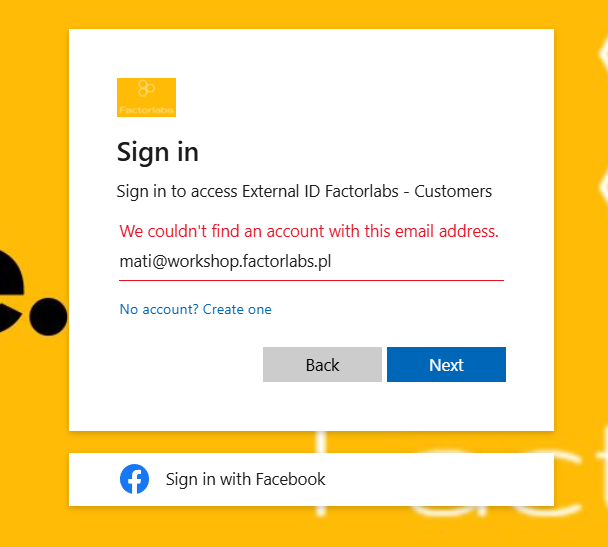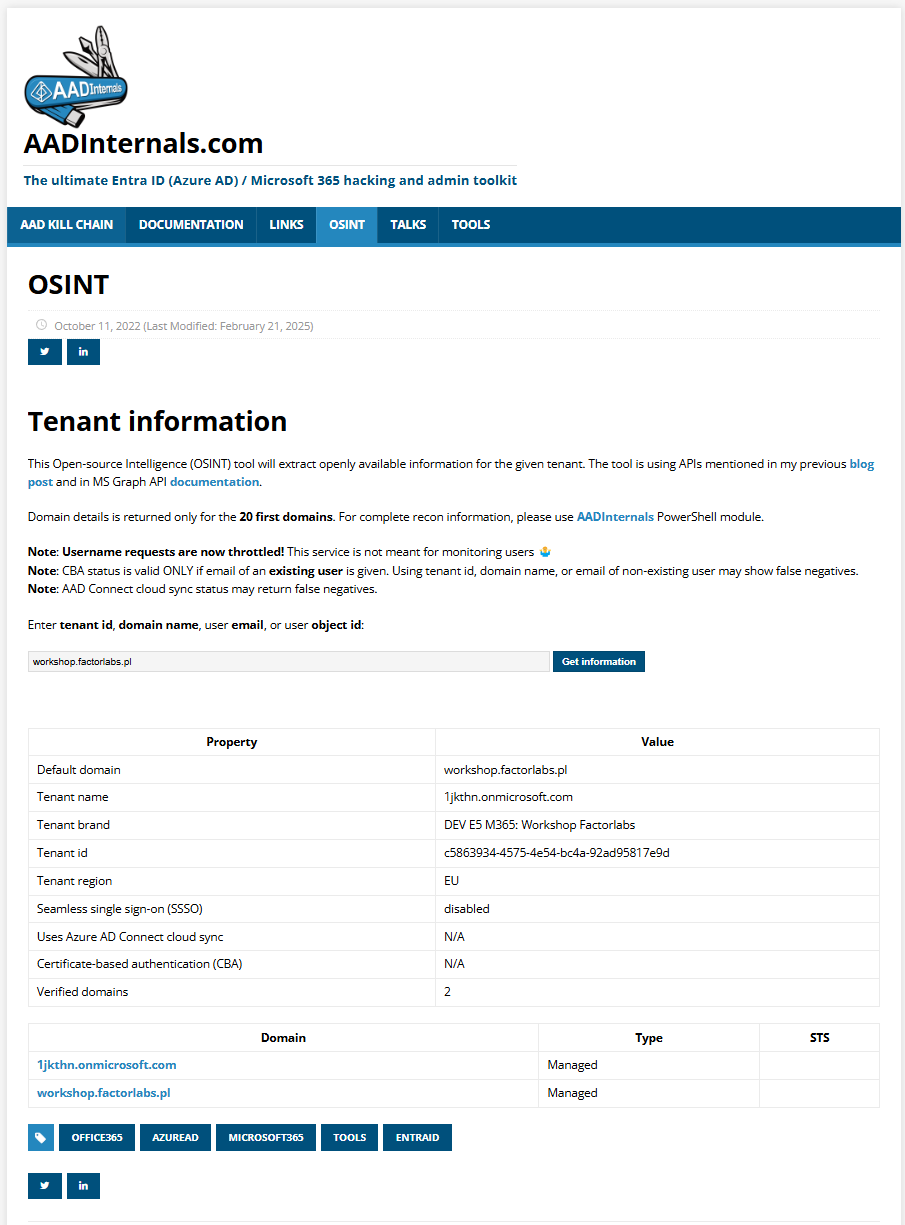
Changelog
- 2025-04-09 - initial version
- 2025-04-11 - updated with AADInternals OSINT tool
Tenant public information
Your tenant-id
With the page https://www.whatismytenantid.com/, you can find your TenantID
How does it work? We can check the Network tab of the browser and find a query to the OpenID Configuration endpoint based on the domain:
https://login.microsoftonline.com/{{YOUR-DOMAIN-HERE}}/.well-known/openid-configuration
^ We can also find a tenant location with the tenant_region_scope field.
^ Whatismytenantid doesn’t work? You can get the same from the website https://gettenantpartitionweb.azurewebsites.net/!
A new tenant helper (scanner)
With the website https://o365.rocks/, you can check if the name for the tenant is free - all tenants are created with {{name}}.onmicrosoft.com domain - so each name should be unique.
AADInternals OSINT tool
We can get full details about the tenant, including:
- Tenant ID
- Tenant Name (onmicrosoft.com domain)
- Domains
- brand name
https://aadinternals.com/osint/
All details in one place like on the screen for my tenant:
Public User Details
userrealm endpoint
Let’s start with the example
with the HTTP GET to my workshop tenant and user Mati
https://login.microsoftonline.com/common/userrealm/[email protected]?api-version=2.1
{
"NameSpaceType":"Managed",
"Login":"[email protected]",
"DomainName":"workshop.factorlabs.pl",
"FederationBrandName":"DEV E5 M365: Workshop Factorlabs","TenantBrandingInfo":null,
"cloud_instance_name":"microsoftonline.com"
}
Nice, but now when we check the mati2 - not existing user, we see that the response doesn’t allow enumerate users. The response is the same for existing and non-existing users.
{
"NameSpaceType":"Managed",
"Login":"[email protected]",
"DomainName":"workshop.factorlabs.pl",
"FederationBrandName":"DEV E5 M365: Workshop Factorlabs","TenantBrandingInfo":null,
"cloud_instance_name":"microsoftonline.com"
}
summary
- We can get details about the user source (tenant) - and review if the tenant exists in the Entra ID realm.
GetCredentialType
After sending a POST request to the endpoint https://login.microsoftonline.com/common/GetCredentialType, we can receive more details about the user. Look at the example:
POST https://login.microsoftonline.com/common/GetCredentialType
Content-Type: application/json
{
"username": "[email protected]",
"isOtherIdpSupported": true
}
Result
{
"Username": "[email protected]",
"Display": "[email protected]",
"IfExistsResult": 0,
"IsUnmanaged": false,
"ThrottleStatus": 0,
"Credentials": {
"PrefCredential": 1,
"HasPassword": true,
"RemoteNgcParams": null,
"FidoParams": null,
"QrCodePinParams": null,
"SasParams": null,
"CertAuthParams": null,
"GoogleParams": null,
"FacebookParams": null,
"OtcNotAutoSent": false
},
"DfpProperties": {},
"EstsProperties": {
"UserTenantBranding": null,
"DomainType": 3
},
"IsSignupDisallowed": true,
"apiCanary": "PAQABDgEAAABVrSpeuWamRam2jAF1XRQE4hLOxSuqm0PBVn6F8MFuh-ioTMYqr4JrzUcvwxH-dWS3zfZ4D32YyFUAgEmogAKk80svE0qlE6DZdiS7eD6u0-2YoXg6TD4D2PYDOUI8hvNLkDVB1jIOowAkHlAOcFAh8jREqUcA_AMyfriklkKp4yw7_p6gOVPOx-Zj_vq4D340F8MkWbAP2jqgefO6W5Vhr9ZzH-30SXX63rQf3kcE5iAA"
}
^ The most interesting response field is IfExistsResult which returns 0 for existing users and 1 for not.
Try it on your own. As a response, we get:
- Branding details from the tenant.
- Keep-Me-Signed-In details.
Entra External ID
I checked the behaviour of the external customer tenant:
- replace common endpoint with tenant GUID
- custom tenant domain instead of
login.microsoftonline.com
I can’t return enumerate the user with that same query, we need to modify the request with the sCtx as originalRequest.
From the Browser perspective, we can enumerate non-existing accounts (and as opposite action existing) with the Entra ID Error message:

{
"username":"[email protected]",
"originalRequest":"{{sCtx}}"
}
To get the sCtx, we need to check the authorization endpoint to Entra External ID. Andy Robbins made a similar try for the Device Code flow at https://posts.specterops.io/browserless-entra-device-code-flow-0802f3bbb91a.
HRD

In general, we should remember that Entra ID Sign-In flow has two steps: home realm discovery (HRD) and authentication(s) methods, we can be:
- asked for PassKey;
- redirected to social login (Google, Facebook, etc.);
- redirected to Entra ID workforce tenant to use corporate credentials.
Summary
- We can enumerate Entra ID Workforce users with the
GetCredentialTypeendpoint. - Enumerating users in the Entra External ID tenant is a bit harder, but it is possible with the
sCtxparameter automatically. It is easy to do with the browser. - There are helper websites to check the tenant name availability and tenant ID.
